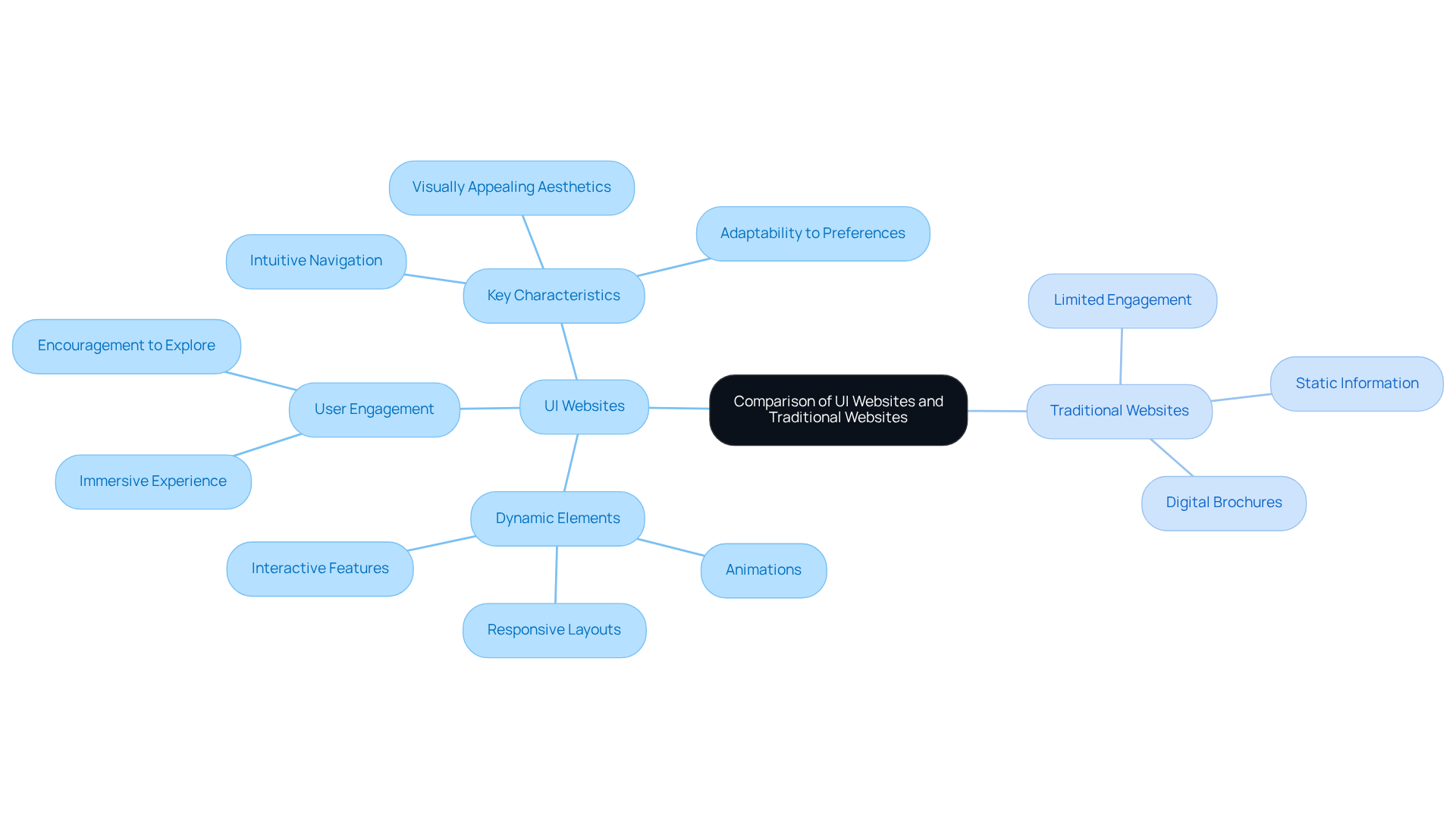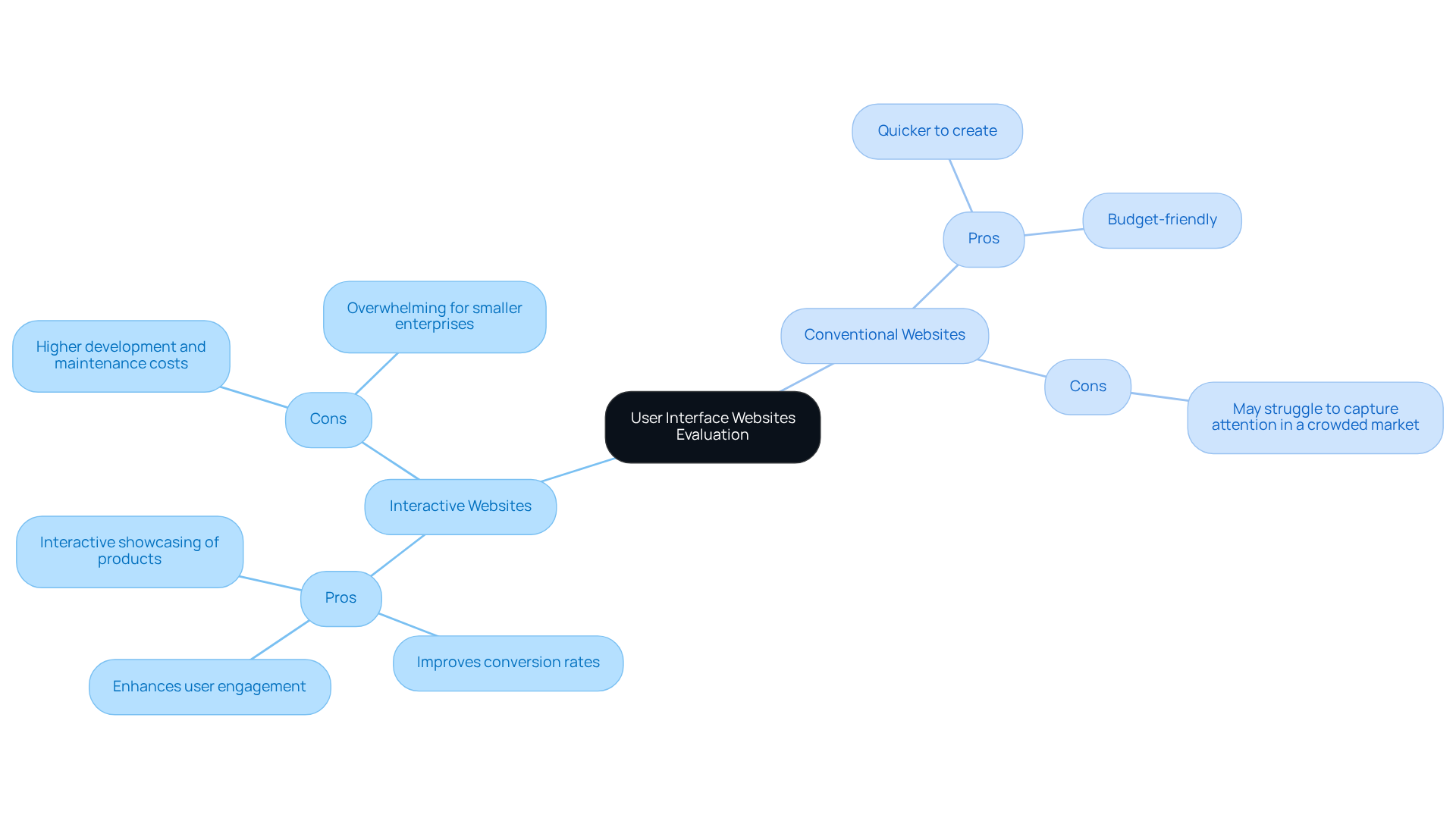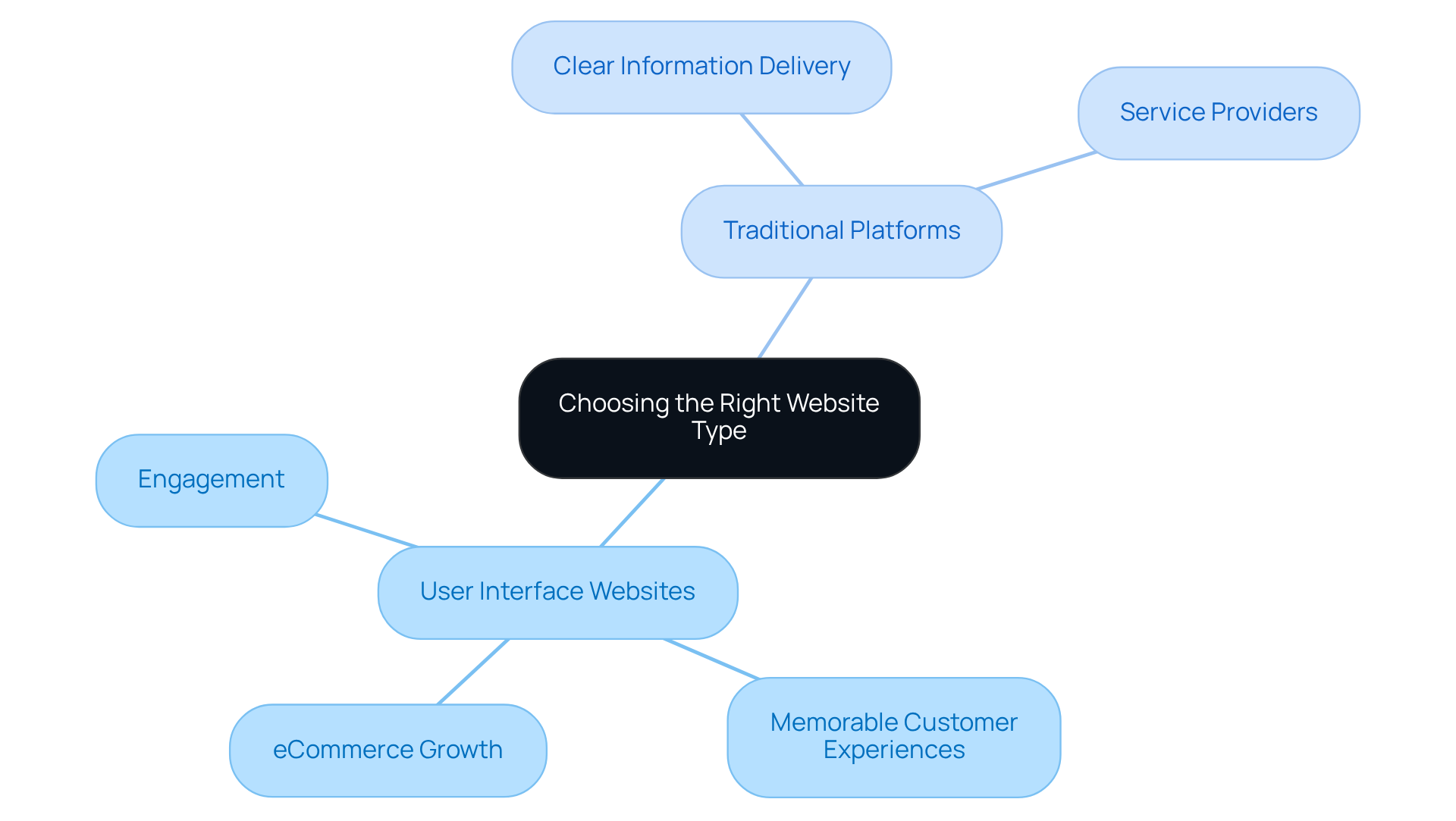Overview
In today's digital landscape, many tech startup founders face a significant challenge: how to effectively engage users. The key differences between user interface (UI) websites and traditional websites highlight this struggle.
- UI websites embrace dynamic interactions and captivating aesthetics.
- Traditional websites often prioritize clarity and straightforward information delivery.
This distinction can be crucial, as UI websites not only enhance user retention but also boost conversion rates through their interactive features. On the other hand, conventional sites may find it difficult to capture attention amidst fierce competition.
It's essential to recognize that these design principles can deeply impact user experiences and, ultimately, the success of your startup. By focusing on creating engaging UI websites, you can foster a more inviting digital environment that resonates with your audience's needs and preferences. Together, we can navigate these challenges and find effective solutions that elevate your online presence.
Introduction
In today's fast-paced digital landscape, businesses face a crucial decision: should they opt for user interface (UI) websites or stick with traditional websites? This choice can feel overwhelming, especially when considering the diverse needs of modern audiences.
UI websites are designed to engage users with dynamic elements and interactive experiences, offering a captivating journey. On the other hand, traditional websites prioritize clarity and straightforward navigation, ensuring that users can find what they need without confusion.
As you navigate this pivotal choice, it's essential to reflect on how each type of website aligns with your goals and the experiences you want to create for your users. This article will explore the key differences between these two approaches, highlighting their unique strengths and challenges.
By understanding these factors, you can make informed decisions that enhance user experience and drive conversions, ultimately supporting your business's growth in the digital realm.
Defining User Interface Websites and Traditional Websites
User interface websites, frequently known as UI websites, pose a challenge for many tech startup founders: how to prioritize user interaction and experience. These sites shine with dynamic elements like animations, responsive layouts, and interactive features that actively engage users. As Steve Jobs wisely pointed out, 'Some individuals believe that aesthetics refers to how it appears. But of course, if you dig deeper, it's really how it works.' This insight reveals a crucial aspect of usability in UI design.
Imagine a world where your audience feels immersed and encouraged to explore, rather than simply consuming information. In contrast, conventional online platforms often come across as static, merely delivering information without fostering engagement. They frequently serve as digital brochures, providing essential details but lacking the interactive elements that enhance the user experience.
Studies indicate that design-focused firms can outperform their competitors by as much as 228%, underscoring the vital role of user interface websites in capturing and retaining audience attention. Key characteristics of user interface websites include:
- Intuitive navigation
- Visually appealing aesthetics
- Adaptability to individual preferences
With simplicity being a cornerstone of creating an effective user experience. Understanding these definitions is essential for evaluating the strengths and weaknesses of each type in various contexts, especially as style trends evolve in 2025. Together, we can navigate these challenges and to create engaging and meaningful experiences.

Comparing Design Principles and User Experience
In the world of web creation, many face the challenge of ensuring that their interface platforms are not only functional but also engaging. Usability is a crucial concern, as intuitive navigation, visually appealing layouts, and interactive elements can make all the difference. When we embrace contemporary style trends like minimalism and flat aesthetics, we pave the way for a seamless user experience that resonates with visitors. Consider this: effective UI can boost a site's conversion rate by as much as 200%, while improved UX can lead to an impressive 400% increase in conversions. This underscores the profound impact that captivating aesthetics can have on engagement.
However, conventional platforms often adhere to traditional principles, prioritizing clarity and straightforward navigation. While they can indeed be visually appealing, they frequently miss out on the that significantly enhance user engagement. This fundamental difference in approach results in varied experiences; UI-focused sites tend to foster greater satisfaction and retention rates, as they encourage a more dynamic interaction with users.
As trends evolve, the importance of prioritizing customer-focused development becomes even more evident. A staggering 74% of companies acknowledge that enhancing client experience is vital for boosting sales, with many firms losing 35% of potential sales due to poor UX. This shift highlights the urgent need for brands to adapt and innovate in their digital strategies. Furthermore, with 62.06% of all internet traffic coming from mobile devices, responsive design is no longer optional—it’s essential for ensuring that everyone has a positive experience across various platforms. By embracing these changes, we can create a more inclusive digital landscape that truly meets the needs of all users.

Evaluating Pros and Cons for Different Use Cases
User interface websites can be a double-edged sword for many businesses. They provide user interface websites that enhance user engagement and improve conversion rates, while also allowing for the interactive showcasing of products or services. However, for smaller enterprises, the need for additional resources in development and maintenance can feel like a heavy burden. It’s understandable to feel overwhelmed by these demands.
On the other hand, conventional user interface websites are often simpler and quicker to create, making them a viable option for businesses with limited budgets or those focused on delivering clear information. Yet, in a crowded digital landscape, these platforms may struggle to , leaving many to wonder how to stand out.
By carefully assessing these advantages and disadvantages, organizations can align their platform choices with their unique use cases and target audiences. Remember, it’s about finding the right fit for your needs, and we’re here to support you in that journey.

Choosing the Right Website Type for Your Business Needs
Choosing the right online platform can feel like a daunting task, especially when it comes to aligning with your organizational objectives and truly engaging your target audience. For those of you in fast-paced sectors like eCommerce and technology, user interface websites often emerge as a preferred choice. They focus on enhancing user interaction and engagement on user interface websites, which is essential for creating memorable customer experiences.
In a market where eCommerce is set to represent 23% of total retail sales by 2024, this focus becomes even more critical. On the other hand, traditional online platforms may serve businesses that prioritize clear information delivery, like service providers or informational sites.
By carefully evaluating your specific goals and available resources, you can choose a website type that not only addresses your immediate needs but also fosters long-term growth and strengthens your branding strategies. This thoughtful alignment is vital, especially considering that 89% of retailers are optimistic about between 1% and 9% in 2024. It highlights the importance of a robust online presence in achieving your business aspirations.
Remember, you’re not alone in this journey; many founders share these challenges, and together, we can navigate them towards success.

Conclusion
Navigating the online presence landscape can be daunting for many businesses, especially when deciding between user interface websites and traditional websites. This choice often feels overwhelming, as each approach carries its own strengths and weaknesses. UI websites shine with their dynamic interactions and visually engaging designs, drawing users in and keeping them engaged. In contrast, traditional websites focus on delivering information in a straightforward manner, which can sometimes feel less inviting. This fundamental difference profoundly impacts how audiences experience content, underscoring the importance of thoughtful design in enhancing usability and satisfaction.
Many founders may find themselves pondering how effective UI design could transform their conversion rates and user retention. It’s a compelling choice for those looking to create memorable experiences. Yet, for smaller enterprises with limited resources, traditional websites may seem like a more accessible option. However, there’s a risk that these simpler sites might fade into the background in today’s competitive digital landscape. By recognizing these dynamics, you can make informed decisions that align your website type with your unique goals and target audiences.
Ultimately, the decision between user interface and traditional websites revolves around your specific business needs and market demands. As the digital landscape evolves, embracing innovative design principles and prioritizing user experience becomes essential for success. We encourage you to assess your objectives, understand your audience's preferences, and evaluate your available resources to choose the platform that best fits your vision. By doing so, you can ensure that your business remains competitive and relevant in its field, fostering a thriving online presence that resonates with your audience.
Frequently Asked Questions
What are user interface websites?
User interface websites, or UI websites, prioritize user interaction and experience, featuring dynamic elements like animations, responsive layouts, and interactive features that engage users.
How do UI websites differ from traditional websites?
UI websites are designed to be immersive and encourage exploration, while traditional websites often appear static and serve mainly as digital brochures, delivering information without fostering engagement.
What is the significance of aesthetics in UI design?
Aesthetics in UI design is not just about appearance; it also encompasses how the website functions, emphasizing the importance of usability in creating effective user experiences.
What are the key characteristics of user interface websites?
Key characteristics of user interface websites include intuitive navigation, visually appealing aesthetics, and adaptability to individual preferences.
Why is the design of UI websites important for businesses?
Studies show that design-focused firms can outperform their competitors by as much as 228%, highlighting the critical role of user interface websites in capturing and retaining audience attention.
What is the importance of simplicity in user experience design?
Simplicity is a cornerstone of effective user experience design, making it easier for users to navigate and engage with the website.
How might UI design trends evolve in the future?
As style trends evolve in 2025, understanding the strengths and weaknesses of UI and traditional websites will be essential for navigating the challenges and opportunities in UI design.




